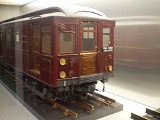
London Underground B Stock
Encyclopedia
The London Underground B Stock was built in 1905 for the Metropolitan District Railway
(now the London Underground
's District line
). 420 vehicles were built, formed into sixty 7-car units.
140 cars were built, divided equally between the two suppliers, in Britain
by both Brush Traction
and Metropolitan Cammell, with the remaining 280 built in France
by Ateliers. 192 of the cars were driving motors, thirty-two were control trailers and the remaining 196 cars were trailers.
These units were wooden-bodied and were based on the prototype A Stock
.
The trailers had wooden underframes as well as wooden bodywork. This proved to be insufficiently robust, resulting in their premature withdrawal. The B Stock motor cars (with steel underframes) were therefore modified as trailers in the early 1920s, the electrical equipment being used for new G Stock
motor cars.
As originally built, the B Stock cars had air-operated sliding doors. This proved to be unreliable and was quickly modified to a hand-operated system, with balancing weights. The hand-operated doors could be opened by passengers whilst a train was in motion. This potentially dangerous system remained in use on some District line trains until the late 1950s. The remaining B Stock cars were later reclassified as H Stock
. Following their withdrawal (by the mid 1940s) all other remaining District line
trains with hand-operated doors were designated as H Stock.
The final cars were withdrawn by the 1940s. Afterwards, at least three cars were transferred into departmental service, being used as a weed killing train. No vehicles have survived into preservation.
The photograph (right) shows a model of a B Stock motor car.
Metropolitan District Railway
The Metropolitan District Railway was the predecessor of the District line of the London Underground. Set up on 29 July 1864, at first to complete the "Inner Circle" railway around central London, it was gradually extended into the suburbs...
(now the London Underground
London Underground
The London Underground is a rapid transit system serving a large part of Greater London and some parts of Buckinghamshire, Hertfordshire and Essex in England...
's District line
District Line
The District line is a line of the London Underground, coloured green on the Tube map. It is a "sub-surface" line, running through the central area in shallow cut-and-cover tunnels. It is the busiest of the sub-surface lines. Out of the 60 stations served, 25 are underground...
). 420 vehicles were built, formed into sixty 7-car units.
140 cars were built, divided equally between the two suppliers, in Britain
United Kingdom of Great Britain and Ireland
The United Kingdom of Great Britain and Ireland was the formal name of the United Kingdom during the period when what is now the Republic of Ireland formed a part of it....
by both Brush Traction
Brush Traction
This article is about a British rail-locomotive maker. For the Detroit auto-maker, see Brush Motor Car CompanyBrush Traction is a manufacturer and maintainer of railway locomotives, part of the FKI group , based at Loughborough in Leicestershire, England situated alongside the Midland Main Line.-...
and Metropolitan Cammell, with the remaining 280 built in France
France
The French Republic , The French Republic , The French Republic , (commonly known as France , is a unitary semi-presidential republic in Western Europe with several overseas territories and islands located on other continents and in the Indian, Pacific, and Atlantic oceans. Metropolitan France...
by Ateliers. 192 of the cars were driving motors, thirty-two were control trailers and the remaining 196 cars were trailers.
These units were wooden-bodied and were based on the prototype A Stock
London Underground A Stock
The A Stock cars were built for the Metropolitan District Railway by Brush Traction in 1903. They were the prototype electric units tested by the Metropolitan District Railway....
.
The trailers had wooden underframes as well as wooden bodywork. This proved to be insufficiently robust, resulting in their premature withdrawal. The B Stock motor cars (with steel underframes) were therefore modified as trailers in the early 1920s, the electrical equipment being used for new G Stock
London Underground G Stock
The G Stock were 50 electric multiple unit train carriages built for the Metropolitan District Railway in 1923 by Gloucester RC&W. They operated on the District line of the London Underground until 1971 ....
motor cars.
As originally built, the B Stock cars had air-operated sliding doors. This proved to be unreliable and was quickly modified to a hand-operated system, with balancing weights. The hand-operated doors could be opened by passengers whilst a train was in motion. This potentially dangerous system remained in use on some District line trains until the late 1950s. The remaining B Stock cars were later reclassified as H Stock
London Underground H Stock
The H Stock classification has been used twice for London Underground stock.The first time was the designation given to examples of B stock that were rebuilt in the 1920s. These were withdrawn from service between 1934 and 1946....
. Following their withdrawal (by the mid 1940s) all other remaining District line
District Line
The District line is a line of the London Underground, coloured green on the Tube map. It is a "sub-surface" line, running through the central area in shallow cut-and-cover tunnels. It is the busiest of the sub-surface lines. Out of the 60 stations served, 25 are underground...
trains with hand-operated doors were designated as H Stock.
The final cars were withdrawn by the 1940s. Afterwards, at least three cars were transferred into departmental service, being used as a weed killing train. No vehicles have survived into preservation.
- Source Underground Train File - Surface Stock 1933 - 1959 Brian Hardy Capital Transport 2002 185414 247 X
The photograph (right) shows a model of a B Stock motor car.

